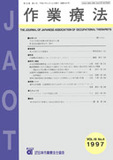Japanese
English
- 販売していません
- Abstract 文献概要
- 1ページ目 Look Inside
- 参考文献 Reference
要旨:リハ専門病院1施設と急性期病院2施設で脳血管障害165名を対象に,発症から退院までのADL変化と障害の重症度及び退院先を検討した.発症4か月以内にADL自立する者は,麻痺が軽く早期回復によるものが主であった.一方発症4か月以降ADL自立に至る者は,重症例が有意に多くADL訓練や環境調整による改善が多かった.失行失認や失語を伴う症例は発症6か月以降退院する者が多かった.ADL総得点が発症4か月時に0点以上,6か月時に40点以上であれば,その後の訓練で自宅復帰可能となる割合が高いことが示唆された.発症6か月以降も入浴動作訓練や家屋環境調整,失行失認に対する生活適応訓練を実施し,ADL総得点が10点以上改善すれば自宅復帰する割合が高かった.
We studied 165 patients with cerebrovascular disease in a rehabilitation hospital and 2 acute-care hospitals in order to examine how the patients' ADL abilities had changed at the time of discharge relative to onset, and how such changes were related to the severity of disability and their destination after discharge. Patients who achieved independence in ADL within 4 months post onset(mpo)had a mild paralysis, and their improvement could be accounted for by spontaneous recovery. In contrast, among those who achieved independence in ADL after 4 mpo, there was a significantly greater number of patients with severe disability, and there improvement in ADL seemed to be due to training and environmental adjustment. Patients who had either apraxia, agnosia, or aphasia, were likely to stay hospitalaized beyond 6 mpo. Patients whose total ADL score was greater than 0 at 4 mpo, or greater than 40 points at 6 mpo, had a high probability of returning home after they had received training. Even after 6 mpo, there was a relatively high probability of returning home for patients who had improved there total ADL score by more than 10 points after having received a training in bathing, environmental adjustment, and adaptation training for apraxia and/or agnosia.

Copyright © 1997, Japanese Association of Occupational Therapists. All rights reserved.


